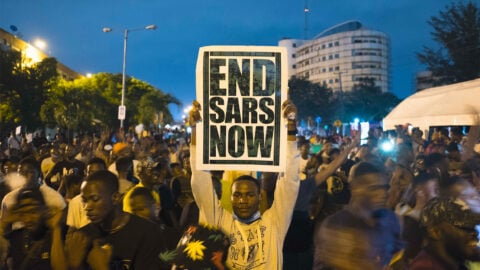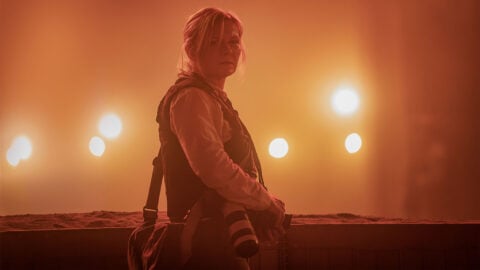Interview: Lola Arias
The name “Lola Arias” might be vaguely familiar but unplaceable for many cinephiles—it was the moniker of the fictional conceptual artist in Ruben Östlund’s The Square who created the titular installation. However, the real Lola Arias, unlike the self-indulgent, international art-speak artistes of Östlund’s film, has attempted to deal with far more serious and immediate issues across her fascinating career in theater, staging works in her home country of Argentina and internationally. Much of her theater work has focused on re-enactments of the recent past, particularly of events that took place during the waning days of Argentina’s military dictatorship (The Year I was Born [2012], Audition for a Demonstration [2014-2017]). These projects, often years in the making, frequently feature the people who experienced the events that are their subject, or employ other nonprofessional actors.
Her first feature, Theatre of War—like her play Minefield, which is currently touring Northern England—brings together British and Argentinian soldiers who fought in the Falklands War in 1982 to discuss and reenact their experiences. Based on accounts from over 70 soldiers Arias spoke to, a group of six veterans recount their (and other soldiers’) traumatic memories of combat, training, and the psychological fallout of the war (such as substance abuse and the suicides of comrades) against blank backgrounds and in locations that may or may not be the same ones they’re talking about. Some stories are repeated several times, while others are told only once. These memories—and their repetitions—are further refracted and gain new meaning through the use of additional media excerpts: Lou Armour, a Royal Marine Commando who recounts killing Argentine soldiers who might have been surrendering, mouths along to the tearful account of the same incident he gave in the BBC documentary The Falklands War—The Untold Story (1987); immediately after dissolving to the original footage, he matter-of-factly tells the camera how he felt ashamed of crying over the enemy on TV (a clip of which comes up immediately with a Google search). The men are also given the opportunity to explain their positions on the Falklands or Las Malvinas to their former enemies, or, alternately, grouse about how “the Argies” behave over beers. Eventually, the men instruct younger actors in reenacting their memories of war, and explain the way they were as young men.
An illuminating and artful meditation on the meaning of conflict, Theatre of War feels even more urgent in an era when the West’s relationship to war is mediated (or entirely hidden from view) by the government’s controls on media. I spoke to Arias at SXSW after the film’s U.S. premiere in the Documentary Feature section.
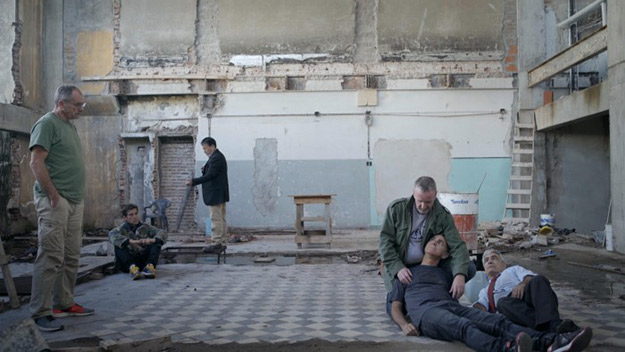
Traditionally when you’re filming a performance, you capture the entire body of the performer, and all the movements, to document the experience of being a spectator in a theater. But in the film version of Theatre of War, the treatment varies: while you’re showing the performer’s entire body, sometimes the backdrop is the place they’re describing, and sometimes it’s not. How does this relate to the body and to the process of documentation?
I think the fact that the film is called Theatre of War says a lot, but that I am a theater director myself produces a lot of confusion around the film. People think that they are going to see a sort of backstage production, like how a theater performance is produced or that’s about theater, and so on. In Theatre of War, I used “theatrical” in the military sense: the theater of war is the place where the war really happens, the territory. For me this idea of creating a territory for [veterans from both sides] to meet—and that this territory is the film in itself—was the most interesting link between “theater of war” as a military term and theater as a space for an encounter, the encounter of these former enemies. The theatricality of the film has more to do with the idea that sometimes it’s about the space.
The world is a set, so to speak, so they are performing in a space that becomes somehow a scenography because they don’t have a realistic relationship with this space. For example, at the start of the film they are on this construction site, reconstructing a memory of the war, and this space is just an empty space that you can connect to different things. You can think about the broken space of memory, you can associate it with different things. But the reality is that it’s just used like the real world is just used as a scenography. And this is how it starts, this relationship between theater and film. The way they perform, you start to realize that there have been rehearsals and that this is not a documentary of people being authentic and spontaneous, but that everything was rehearsed. So the theatricality is more the fact that they are performing something that they have already performed before [in preparation for the theater or for this film], or that they are rehearsing, or that they are somehow very aware of the fact that they are performing. They are not there in front of a camera; there’s an awareness.
That repetition relates to post-traumatic stress disorder, where the mind repeats a traumatic event again and again. But the repetition here also seems to be about regaining control over these memories. What was your original process working with them, getting these stories out, and making something large and uncontrollable into something controllable?
I think that’s a good association: the idea of what is controllable and what is uncontrollable in terms of the process of memory. When Lou [Armour] says at the end that there is this image that comes back—the body of that dead soldier—whether he’s in a train or out running, he’s talking about the idea of the flashback, the return of an image that he can’t get rid of. They re-appropriate their own memories in the film and they perform them, and with this performance they gain a distance and can see their story from outside. They can perform it with their former enemy and somehow also have a new perspective on their own story. There is a process of being able to reflect on it and not just being smashed by the enemy. This is a very singular way of going back: you’re sharing it with the person you were fighting against and that creates a bond between them that is strong, and still is, because the play is touring all over the world. They are not alone with their own ghosts, and that is something very important in this film: creating this group that will empower them.
Even though they went through this on opposing sides, it’s still a shared experience, a discrete event in history that will never happen again. It’s a fascinating exercise, because they’re achieving the catharsis, healing, and reconciliation that cannot happen on a political level.
Sometimes when we use “reconciliation,” we mean giving away your own ideology or your own cause in order to forgive and forget. The special thing about this project is that they get together, but they don’t have to give away their cause. They don’t have to agree in order to be together or work together. I think that’s also the most political aspect of the film: how can we work together even if we don’t agree? Even if we are enemies, we still can work together, we still can hear each other. We are different people and we were on different sides, but we can do something without giving up on what we think.
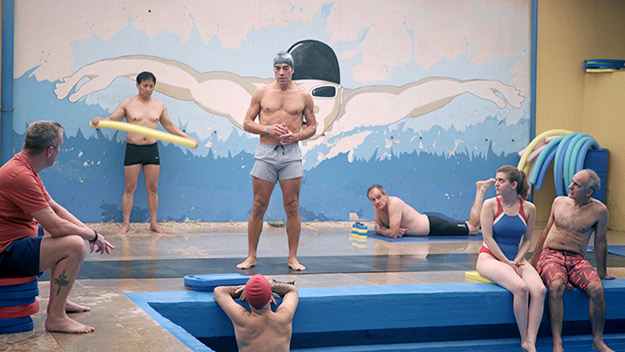
You see the cross-cultural exchange at the scene in the nightclub, where the British people are complaining about the Argentinians and then the Argentinians are complaining about the British. Obviously this “dialogue” came from interviews and the actual experience of working with them, and getting their stories. How did you transform those experiences into an emotional arc, sequencing things in a way that makes sense but also creates doubt whether what we’re seeing is real or fake, rehearsed or spontaneous?
For me it was important to show that during the entire process of creating this project—which is a video installation, a play, and a film—we went through different moments of crisis. One of the central points of crisis was from the British side, the fear that because I am Argentine, I couldn’t take a neutral perspective: the project was going to be an Argentine project about Argentine suffering and the Argentine struggle. The British were the visitors, because most of the process of the shooting and everything took place in Argentina, and they were in the tough position of discussing everything and rejecting things. And the Argentines were the ones asking themselves, “What is it about the British? Why are they complaining so much? We don’t understand them… but at the same time we do understand them.”
There’s a scene where one of the Argentinians says to Marcelo [Vallejo, an Argentinian veteran], “Do you have a special connection with Lou?” and he says, “Maybe it’s about suffering.” So you see that there is this cultural gap between them and different ways to go through the process, but at the end what is more important is this connection. Also the scene with Sukrim [Rai, a British soldier, talking to his wife via Skype], who is a Gurkha, shows that there is a third culture in the whole encounter, and that there’s one more layer that has to be considered. He belongs in the British Army, but his mother tongue is not English, so he had to go through a more difficult process than all of them.
Sukrim’s inclusion shows a larger aspect of this conflict, which is that there were two colonial powers fighting over land that was never theirs to begin with. In the U.S., the conflict is generally understood in terms of British anxiety about their empire being in decline and losing their colonies, which they overcompensated for with a big war over small islands. How do you feel like shared experiences of masculinity and colonialism made their problems worse, but also gave them shared ground to connect to each other?
It was not only about Margaret Thatcher trying to gain popularity at a moment when she was fighting the unions and trying to make a big turn in the policies in Britain—she was re-elected the year after the war, so it worked. But on the Argentinian side, this war took place at a moment when [Leopoldo] Galtieri, the general in charge of the military dictatorship, was also losing power and wanted to gain popularity. This war had a very concrete political purpose in both countries, and that’s why there’s this scene when the masks [of Thatcher and Galtieri] are kissing: they both wanted this war. It wasn’t a one-sided war that one side tried to cope with. This goes back to colonial times, but it was important in 1982 for both countries.
In terms of masculinity, it was interesting for me as a female director to work with them. They are men who are at the end of their fifties, who have been soldiers, who have never worked in the context of art. They have never been directed or ordered around by a woman. When they were joking they would say, “Here she comes, the commander-in-chief.” So it was a difficult thing to accept, and we had some issues with power and how they accepted me being director and so on, but on the other hand, the fact that I was a woman created another kind of bond between them and me, and they didn’t feel threatened or that they had to compete with me as they would probably have felt with a man. They could create another kind of relationship. They didn’t feel that I was going to threaten whether or not they were “heroes.” I was always saying, “This is not about if you did a good job, if you were a hero. I don’t want any hero stories here.” They let themselves open up more and also reflect more on the uncertainty of what they did and what it meant.
In Lou’s scenes I’m always surprised how he says, “I shot into the trench and suddenly people went out with their hands up, and I asked myself, have I just killed someone who tried to surrender?” These questions, these open questions that stay in their mind 35 years later, they could tell to me because I was not going to judge them. I understand that somebody shoots and five seconds later he’s asking himself, “What have I done? Was it the right moment to shoot? Were they surrendering and I shot them?” It’s so confusing, being in the battlefield. I think that’s also something that happened also because I was a woman.
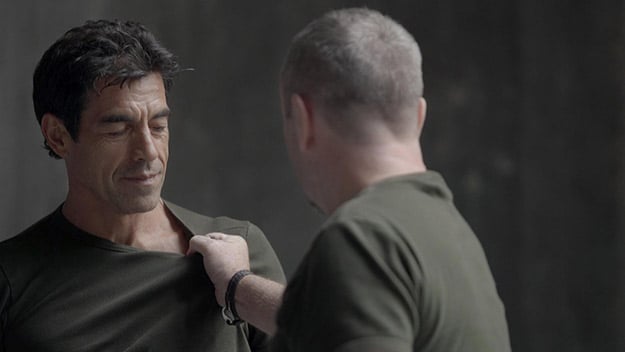
When you were writing and paring down their testimonies, did you approach that with a certain philosophy of how you wanted to help them reenact history?
I have been working on this film for 10 years, so I’ve been doing many different projects which deal with the difference between “History” and the personal stories and the relationship between how we tell the stories, the relationship between experience and narrative. I did different projects in different moments that are dealing with this connection, so for me it’s always important to focus on the person’s perspective, and try to go back to what have you experienced. Don’t tell me the stories of the others, don’t tell me what you read, what you knew afterwards, the stories that were written in books. Tell me your memory, your story, the stupid things that you remember.
That was the most important point from the beginning, and the central question in the audition was, “What is the moment of war that has stayed in your memory until now? What is the thing that you can’t forget?” Sometimes they talked around this question, sometimes they didn’t know and they had to go through their experience, and you find a central story that condensed the whole meaning of war for them. This is why, for example, in the case of Lou, whose story is repeated in different ways, in the editing room it was asked, “Oh, we’re telling this story again?” Yes, because it’s this story that keeps coming back, and we’re working on how to tell this story—how he told it in ’84, how he says it now in this documentary, how he performs it with the others, how he does it when somebody else is performing. The idea is that there is a strong memory which somehow stays as a kind of rock in the mind and keeps coming back, and how to work on that, how to make it, in a way, not as heavy. That’s the point: how to put it out.
You were talking about working with these nonprofessional actors who have grown into actors. Aside from joking about resenting your “orders,” what was the process of working with them like?
I don’t like the word “non-actor,” because I think if someone is performing and he does it well then he’s a professional actor. It doesn’t matter if he studied at the Royal Academy or if he stepped onto the stage for the first time. There is a training that happens when you’re doing these pieces, so they are being trained as actors during the process of reconstructing. They became very professional actors, so they were able to repeat and change stance and change moods and do things that only actors can do. Of course the fact that they came from the military made it easier to have some kind of discipline, because training is also about repetition. When they train in the military, they also repeat a kind of choreography that is performed. So they were used to repeating and repeating, because the training of a soldier is in some ways like a rehearsal for the war—and they’ve done a lot of rehearsals, as it were.
Considering that a film, unlike a performance, is a discrete thing that travels around the world, were there things that you wanted to try and make clearer?
The difference between the play and the film in a way is that the play is always in the present. When you’re in the theater, it’s always present. They’re there, you see them, you hear them telling the story, and you know it’s them, now. And they will change because they grow, they get older, they do things in a different way, you’re in the present time. In film, it’s a capsule of time. You put together things that were filmed in different moments in time so you can reflect more on the idea of a process. In the film you see the process from the very beginning of the auditions, the first time they told their story in front of the camera, until the end when they’re performing it with the help of these young actors, and they watch the young actors performing their stories at the very end. It’s a process of giving away their own stories. And this is something that can only happen in the film: thinking about who is going to tell the story next.





